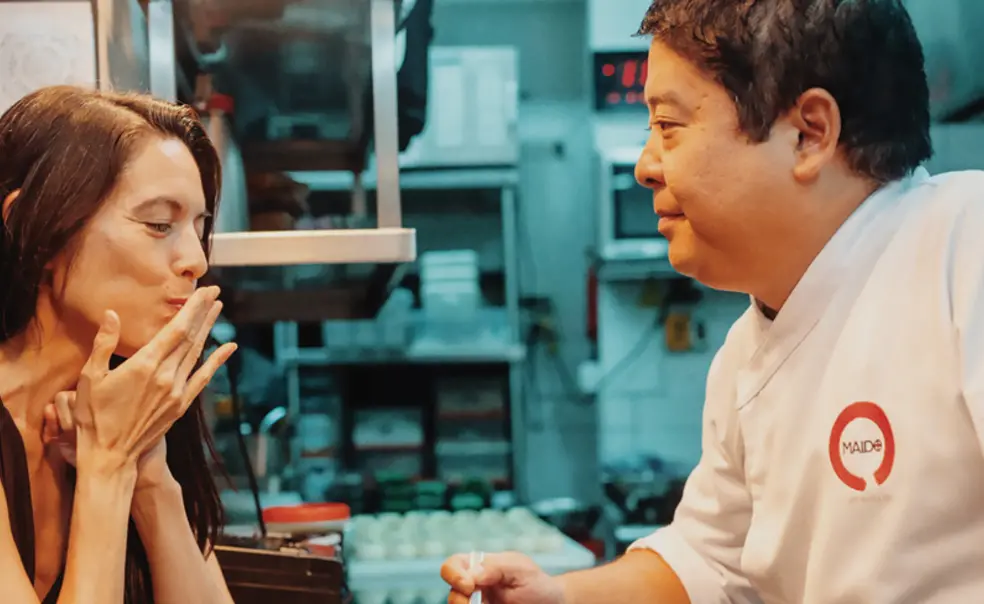New York Times Critic Ligaya Mishan ’91 Seeks Magic in the Dining Experience
‘Restaurants are some of our last gathering places,’ Mishan says.
The first night after Ligaya Mishan ’91 was announced as one of The New York Times’ two chief restaurant critics, she was nervous she’d be recognized on her review assignment. Food critics often make reservations under aliases because they don’t want restaurants to give them special treatment; their role is to assess the dining experience from the perspective of the general customer.
“I slunk into the dining room right behind the people I was dining with,” Mishan says. She sat with her back to the room, which was very dark. “Slowly I felt like, it’s going to be OK — even if they know who I am, no one’s going to say anything.” In the end, all was well. “Nothing seemed different,” she says. “I’d actually been to the same restaurant before, and the service was the same.”
Shakespeare reportedly said that “heavy is the head that wears the crown.” For a Times food critic, heavy is their plate. Critics go out to eat 5-6 times a week, often sampling the same restaurant up to three times to get a full sense of an establishment’s menu. The last Times critic, Pete Wells, stepped down in 2024, and in his farewell essay he said he was folding up his napkin because the demands of the job were threatening his health. “My favorite movie critic is still Pauline Kael, who wrote as if she had seen every film ever made,” Wells wrote. “But movies won’t, as a rule, give you gout.”
In June, the Times named Mishan and her colleague Tejal Rao as Wells’ successors. By splitting the role, the two critics aim to cover more terrain than just New York City. While Rao will focus on restaurants across the U.S., Mishan will split her time covering New York and the rest of the country. According to Mishan, the increased editorial scope reflects their desire to recognize restaurants as a key part of the fabric of America. “Restaurants are some of our last gathering places,” she says. “These are actually precious institutions that we should take an interest in and protect in some way and champion.”
Growing up, Mishan never expected to be a food critic, but even at a young age she detected the wonder possible in the dining experience. In her hometown of Honolulu, her family rarely went out to eat, but on special occasions, they ate at the Columbia Inn, a storied diner founded by an Okinawan family. “I would get breaded veal cutlets and there’d be maraschino cherries,” Mishan says. “I remember that the waitress would come and all of the plates would be in the spiral up her arm, and it seemed just magical.”
At Princeton, Mishan majored in English, frequented “the Wa,” haunted a bagel place in town, and once had a date at Winberie’s. “I wasn’t a gourmet,” she says. “I mostly ate for survival.” She wrote her thesis on the modernist poet H.D., whose legacy as a writer had long been overshadowed by the poet’s stormy relationship with Ezra Pound.
Mishan continued her study of poetry with a Master of Fine Arts at Cornell, graduating in 1995. After working as a restaurant hostess in Honolulu, which she says gave her insight and sympathy into the challenges of the food-service industry, Mishan rose through the ranks of The New Yorker and found a voice as a restaurant reviewer. From 2012 to 2020, Mishan wrote the “Hungry City” column for the Times, spotlighting many unpretentious hole-in-the-wall restaurants founded by immigrants.
“[The column] gave me this entry into all these worlds, all these corners of New York that I hadn’t known about before, and I was taking the subway deep into different boroughs and going far beyond where the subway ended,” Mishan says. “The element of discovery was a beautiful thing, and I was also free of the burden of assigning stars, so I could just appreciate a restaurant for what it was, without having to measure it against some standard that it just couldn’t meet because they didn’t have the resources.”
Despite the prestige of her new role as a chief critic, Mishan’s interest in a wide range of culinary experiences has not diminished. When one of her friends expressed embarrassment at going to dinner at the chain restaurant Margaritaville, Mishan recalls being encouraging. “There are different restaurants for different moments,” she says. “There’s room for all of it.”












No responses yet